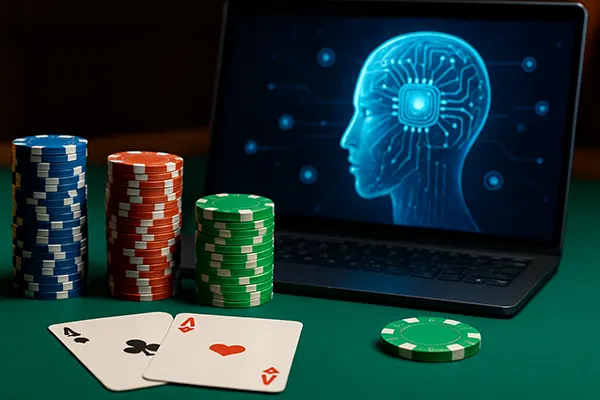
Artificial Intelligence in Online Poker: New Tools for Players
Artificial intelligence (AI) is no longer a futuristic fantasy — it is a present-day reality that’s shaping multiple industries, including online poker. As of February 2025, players have access to advanced AI-driven tools that are transforming how strategies are developed, games are analysed, and decisions are made at the tables. This evolution brings both opportunities and challenges that demand a closer look at how AI is impacting poker players today.
AI-assisted analysis and decision-making
One of the most significant developments in the application of AI in online poker is its ability to analyse gameplay in real-time. Sophisticated software can now interpret betting patterns, evaluate hand strength, and even predict opponents’ next moves with remarkable accuracy. These tools can offer players a strategic edge previously available only through years of human experience.
Modern solvers such as PioSOLVER and GTO+ have seen dramatic improvements, integrating machine learning algorithms that learn from vast datasets of played hands. These tools don’t just provide optimal decisions based on game theory optimal (GTO) models but also adapt to exploitative strategies by adjusting to an opponent’s tendencies.
Importantly, the usage of these AI tools is generally limited to post-game analysis rather than live game assistance, especially in regulated environments. Most online poker rooms prohibit the use of real-time assistance software to maintain a level playing field. Nonetheless, many players study with AI tools outside of games to refine their skills and minimise mistakes.
Implications for player education and improvement
Artificial intelligence has revolutionised how players learn and improve their gameplay. Training tools powered by AI allow users to simulate millions of hand scenarios and receive feedback on their decision-making. These simulations help in developing both intuition and technical precision.
AI-driven coaching platforms such as DTO Poker Trainer and Lucid GTO have grown in popularity, offering interactive sessions with hands tailored to specific weaknesses. Instead of relying solely on human coaches, players now receive instant guidance, enabling faster improvement and deeper understanding of complex game dynamics.
Additionally, AI tools are making poker more accessible to newer players. With structured feedback loops and custom learning paths, even those with minimal experience can progress quickly, helping to democratise the game and expand its global player base.
Detection and prevention of unfair play
As AI empowers players, it also strengthens the integrity of online poker rooms. Advanced algorithms are used by security teams to monitor for signs of collusion, bot usage, and other forms of cheating. These systems process massive amounts of data in real-time to detect irregular behaviours that may indicate automated play or coordinated actions among users.
Pattern recognition algorithms have become essential for detecting bots — software programs that play poker without human involvement. These bots often follow mechanical decision-making paths, which AI can now flag with high accuracy based on deviations from expected human gameplay.
Additionally, AI models have improved in identifying shared strategy use between players. By analysing betting synchrony and repeated move sequences, poker operators are now more equipped than ever to prevent unfair advantages, protecting recreational and professional players alike.
Balancing innovation with ethical concerns
Despite the benefits AI brings, its integration into online poker raises important ethical questions. The boundary between legitimate study tools and prohibited real-time assistance continues to blur, forcing platforms and regulators to update their policies regularly to stay ahead.
There are also concerns regarding accessibility. Not all players can afford subscription-based AI coaching tools or solvers, which may create a competitive gap. This calls for more transparent guidelines and possibly the introduction of publicly available study resources.
Another major issue is data privacy. As AI tools increasingly rely on tracking player behaviour, it’s essential that data is collected ethically and anonymised to prevent misuse or commercial exploitation. Striking a balance between innovation and fairness remains a key task for the industry moving forward.

AI in tournament forecasting and bankroll management
Artificial intelligence has found a vital role in predictive analytics within the poker ecosystem. AI algorithms can now forecast tournament outcomes by analysing player fields, historical performance, and structure-based variables. This allows players to better plan their schedules and optimise participation for maximum expected value (EV).
For bankroll management, AI tools assess risk in real time, helping players decide which stakes are suitable based on performance trends and statistical variance. Custom tools track buy-ins, win rates, and streaks to advise players when to move up or down in stakes to maintain financial health.
These innovations have already shown positive results. Players using AI-backed financial tools report fewer busts and more stable growth. For professionals relying on poker as an income source, such technologies are no longer optional but essential for long-term sustainability.
Future outlook and ongoing developments
The integration of AI into online poker is still in a dynamic phase. In 2025, developers are focusing on enhancing user interfaces and creating explainable AI systems that don’t just deliver answers but justify them. This will help players understand the rationale behind every move recommendation and increase trust in the technology.
We also see early experiments with AI-based peer review systems. These allow players to upload hand histories and receive feedback not just from algorithms but also from a crowd-sourced base of trained users, blending human insight with machine precision.
Looking ahead, it’s likely that regulators, operators, and developers will continue to collaborate on setting boundaries that preserve competitive fairness while encouraging innovation. The key will be to ensure that AI remains a tool for growth — not a crutch or a method of exploitation.



